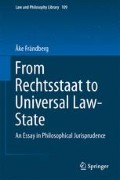Abstract
Since law-state thinking deals with abuse of legal orders it is appropriate to explain the concept “legal order”. That is done in this chapter. Legal orders are viewed from four different view-points, a morphological, an ontological, a praxeological and a teleological one. From a morphological view-point a legal order is regarded as a relation between a legal system—a system of legal rules, or norms, N,—and a legal organisation, O, such that norms of N constitute O and the function of O is to handle (create, apply, execute) norms of N. Legal organisations are sets of legal positions. Both legal systems and legal organisations consist, ontologically, of normative phenomena, i.e., a kind of human ideas. The praxeology of legal orders investigates the handling of legal orders by their functionaries and the teleology of legal orders investigates the general goals of such orders.
Access this chapter
Tax calculation will be finalised at checkout
Purchases are for personal use only
Notes
- 1.
Å. Frändberg, “Morphological levels as a tool for the general study of law”, in Justice, Morality and Society. A tribute to Aleksander Peczenik on the occasion of his 60th birthday 16 November 1997, A. Aarnio, R. Alexy, G. Bergholtz, eds. (1997), pp. 147–158.
- 2.
J. Bentham, Of Laws in General, ed. H.L.A. Hart, (1970), J. Austin, The Province of Jurisprudence Determined and the Uses of the Study of Jurisprudence, ed. H.L.A. Hart (1954).
- 3.
A.J. Merkl, “Prolegomena einer Theorie des rechtlichen Stufenbaus”, in Gesellschaft, Staat und Recht. Festschrift für Kelsen (1931), pp. 252–294. H. Kelsen, General Theory of Law and State (1945), Reine Rechtslehre, 2nd ed. (1960).
- 4.
A. Ross, On Law and Justice (1958), H.L.A. Hart, The Concept of Law (1961), J. Raz, The Concept of a Legal System (1970).
- 5.
R. Dworkin, Taking Rights Seriously (revised ed., 1978).
- 6.
Cf. M.P. Golding, Philosophy of Law (1975), ch. 1.
- 7.
For a thorough analysis of legal positions, see L. Lindahl, Position and Change (1977).
- 8.
Cf. H.L.A. Hart, “Definition and Theory in Jurisprudence” (70 Law Quarterly Review, 1954).
- 9.
It should be obvious that my concept “institution” is something completely different from the concept named by the same term in N. MacCormick and O. Weinberger, An Institutional Theory of Law. New Approaches to Legal Positivism (1986).
- 10.
I have found ideas concerning the ontology and instrumental character of law very similar to my own in P. Amselek, “Le droit dans les esprits”, in Controverses autour de l´ontologie du droit, ed. P. Amselek and C. Grzegorczyk (1989), pp. 27–49.
- 11.
Cf. Å. Frändberg, “Some Aspects on Rationality in Legislation”, in Juristische Logik, Rationalität und Irrationalität im Recht, eds. A.-J. Arnaud, R. Hilpinen, J. Wróblewski, Rechtstheorie, Beiheft 8 (1985), pp. 123–137, at pp. 129 − 134.
- 12.
For a painstaking discussion of the arguable character of law and its relation to the rule of law see N. MacCormick, Rhetoric and the Rule of Law (2005).
- 13.
Cf. J. Raz, “The Functions of Law”, in J. Raz, The Authority of Law (1979), Ch. 9 (first published in A.W.B. Simpson (ed.), Oxford Essays in Jurisprudence, 2nd series (1973)).
- 14.
When reading literature within the field of general analytical jurisprudence, or philosophy of law, or listening to speakers lecturing in this field, I have developed a habit of diagnosing what is discussed by means of the following 7-piece typology of problems—(i) ontological, (ii) morphological, (iii) teleological, (iv) praxeological, (v) methodological, (vi) ideological (evaluative) and (vii) epistemological problems—which, I have noticed, helps a bit. While methodology has a meta-character in relation to praxeology, ideology has a meta-character in relation to both praxeology and methodology. The present essay is, on the whole, a study in the ideology of legal orders. Epistemology has, by its very nature, a meta-character in relation to each of (i)—(vi).
- 15.
See E.P. Evans, The Criminal Prosecution and Capital Punishment of Animals (1906).
- 16.
J. Locke, Two Treatises of Government. The Second Treatise (93), (1689).
Author information
Authors and Affiliations
Corresponding author
Rights and permissions
Copyright information
© 2014 Springer International Publishing Switzerland
About this chapter
Cite this chapter
Frändberg, Å. (2014). Legal Orders. In: From Rechtsstaat to Universal Law-State. Law and Philosophy Library, vol 109. Springer, Cham. https://doi.org/10.1007/978-3-319-06784-1_2
Download citation
DOI: https://doi.org/10.1007/978-3-319-06784-1_2
Published:
Publisher Name: Springer, Cham
Print ISBN: 978-3-319-06783-4
Online ISBN: 978-3-319-06784-1
eBook Packages: Humanities, Social Sciences and LawLaw and Criminology (R0)

